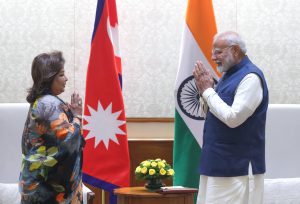Nepal’s new Foreign Minister Arzu Rana Deuba is in India this week for a series of high-profile meetings. Deuba was originally scheduled to fly to New Delhi for a routine health checkup. But given the political circumstances surrounding India-Nepal relations, New Delhi upgraded her visit to an official trip, and Deuba even got a rare audience with India’s Prime Minister Narendra Modi.
Deuba’s visit to India is her first foreign trip since taking charge of Nepal’s Foreign Ministry last month under the country’s new Prime Minister K.P. Sharma Oli. That detail is not by itself very significant: Since it became a republic 17 years ago, Nepal has seen a change of prime minister as many as 13 times — often a result of shifting alliances between the three major political parties in the country’s divided parliament. Oli himself has now become prime minister for a third time. His two main rivals, Sher Bahadur Deuba (Arzu Rana Deuba’s husband) and Pushpa Kamal Dahal, have each been prime minister for five and three terms respectively. None of them has ever completed a full term in office so far.
Yet, Deuba’s trip to New Delhi is still significant. The last two times that he was in power, Oli pivoted hard toward China and ran up a long gamut of spats with India. He faced down an economic blockade from New Delhi, raked up old territorial disputes along the border, and signed a landmark agreement with Beijing to reduce his country’s dependence on Indian trade routes. With Oli back in power, India is now trying to get out in front, especially as it faces a series of politically unfavorable developments elsewhere in the neighborhood — from Bangladesh to the Maldives.
Nepal is important not just to India but also to the United States. Nestled between India and China in the strategically contested Himalayas, Nepal is an important player in checking China’s influence in South Asia.
As in most other parts of Asia, the path to winning influence in Nepal runs through the economy. Much like the rest of the region, Nepal’s economy suffered hard during the pandemic. Tourism revenue — a key driver of growth — dried up, causing trade imbalances and inflation. According to a government survey, unemployment stood at 12.6 percent in 2022-23 — up from 11.4 percent in 2017-18 before the pandemic. Not by coincidence, Nepal has become the unlikely source of the largest contingent of foreign mercenaries fighting for the Russians in Ukraine — as many as 15,000 of them, according to some reports.
China has already entered and dominated the fray. Like other South Asian economies, Nepal sees economic ties with China as a way to break free from New Delhi’s historic hegemony. In recent times, Chinese imports have surged while imports from India have declined. Earlier this year, Nepal and China teamed up to drill for oil in the former’s territory as a way to reduce Nepal’s dependence on oil imports from India — a key strategic objective for Kathmandu after New Delhi imposed an economic blockade on its fuel imports in 2015 over a political dispute. There have also been reports of possible projects under China’s flagship Belt and Road Initiative.
But while Nepal pivots to China, the United States has not stood by idly. In recent years, Washington has tried to build its own presence in Nepal. In 2017, a $500 million compact was signed to build critical infrastructure, including the facilitation of cross-border electricity trade between Nepal and India. Last week, U.S. Deputy Secretary of State Richard Verma was in Kathmandu, pledging $100 million in military support.
Ordinarily, India is very sensitive to such activities in its neighborhood by major world powers. But in the wake of sundry disputes with Nepal and others in the region, New Delhi increasingly recognizes that it might not be able to ward off China’s economic influence alone. That has created more space for the U.S. to coordinate with India in neighborhood relations. Perhaps tellingly, after Verma went to Nepal last week, he was warmly welcomed in New Delhi by India’s Minister of External Affairs Subrahmanyam Jaishankar.
For New Delhi, such collaboration with the U.S. has become increasingly pivotal. In recent years, India’s rise as an emerging power has been accompanied by testy relations with the neighborhood. Countries like Nepal have naturally pursued a policy of strategic autonomy by pivoting to China, to counterbalance India. Washington’s entry into the region with economic assistance programs of its own will be to India’s benefit.

































